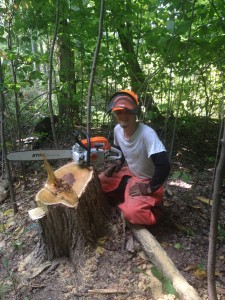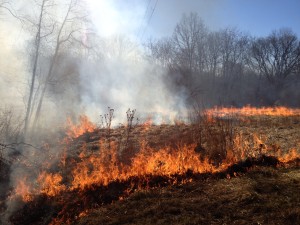Invasive Species Control (ISM): Invasive species are organisms that are from other parts of the world, have no natural predators and reproduce at an extraordinary rate. Because they do not have any predators that put them into balance with our native flora they produce large monocultures and make it hard for our native plants to survive. So we have to intervene and remove the glitch in the system. This includes going to the customer’s property and determining the amount, location, and the number of species of problem plants. We then work up a plan and price estimate to remove the pests. If the landowner agrees we then use the appropriate chemical, mechanical, and/or manual methods to safely and effectively remove the problematic species.
Timber Stand Improvement (TSI): One of the symptoms of lack of fire in our forests is mesophytic encroachment. This is the spread of tree species that belong in the bottom lands into the upland s, where they shade out and prevent new seedlings of Oaks and Hickories from germinating. Oaks and Hickories are both more commercially valuable and ecologically valuable species than mesophytic species. Fire usually restricts the mesophytic species to the bottom lands but when fire is excluded for a long time reintroduction of fire will not remove the older trees from the landscape. This is when we use timber/forest stand improvement to control the number of older bottomland tree species in the stand. To do this we use chemical, and mechanical treatment methods to remove the species of trees that are undesirable or that are overabundant. This allows the oaks and hickories to grow more freely by increasing the light that reaches the forest floor which allows oak and hickory seeds to germinate and a greater diversity of other plant species to occur.
s, where they shade out and prevent new seedlings of Oaks and Hickories from germinating. Oaks and Hickories are both more commercially valuable and ecologically valuable species than mesophytic species. Fire usually restricts the mesophytic species to the bottom lands but when fire is excluded for a long time reintroduction of fire will not remove the older trees from the landscape. This is when we use timber/forest stand improvement to control the number of older bottomland tree species in the stand. To do this we use chemical, and mechanical treatment methods to remove the species of trees that are undesirable or that are overabundant. This allows the oaks and hickories to grow more freely by increasing the light that reaches the forest floor which allows oak and hickory seeds to germinate and a greater diversity of other plant species to occur.
Ecological Restoration: This is the process of taking degraded land and putting the pieces of the ecosystem that are missing back into the appropriate places to restore the ecosystems functions. Think of it like a car that is broken down. A mechanic will diagnose the problem, and replace the parts that are not functioning so your car will function the way it is supposed to. We do the same thing only with ecosystems. We determine what is missing from the landscape and attempt to put things into place to allow the ecosystem to start to recover and function again.
Controlled Burn Implementation and Coordination: Long before European settlers were here fire was both naturally occurring and used by Native Americans to manage the forests of our area. This means our plant species have adapted to periodic  fire events. But for the last 80 years, fire has been excluded from the landscape. Taking fire away from a fire-adapted species is like taking away light from a species that grows in an open field. It is a necessary part of the fire-adapted species’ life cycle. Due to this, our forests are failing to maintain the high diversity of life needed to sustain ecosystem functions. We need to reintroduce fire back into these systems. However, fire is a dangerous and destructive force, and we cannot just let natural forest fires burn. That is where controlled burns come in. Controlled burns are a safe way of introducing fire back into the ecosystems that need it. Ozark Koala performs small controlled burns, up to 25 acres. We can also coordinate larger burns with external groups, like the Southern Illinois Prescribed Burn Association.
fire events. But for the last 80 years, fire has been excluded from the landscape. Taking fire away from a fire-adapted species is like taking away light from a species that grows in an open field. It is a necessary part of the fire-adapted species’ life cycle. Due to this, our forests are failing to maintain the high diversity of life needed to sustain ecosystem functions. We need to reintroduce fire back into these systems. However, fire is a dangerous and destructive force, and we cannot just let natural forest fires burn. That is where controlled burns come in. Controlled burns are a safe way of introducing fire back into the ecosystems that need it. Ozark Koala performs small controlled burns, up to 25 acres. We can also coordinate larger burns with external groups, like the Southern Illinois Prescribed Burn Association.
Fire Line Construction: For a burn to be controlled you have to know where it starts, where it goes and where it stops. In order to do this fire lines are constructed around the area to be burned. These lines are constructed by removing all potential fuel, like leaves, dead grass, sticks, and logs, for 5-10 feet all the way around the burn area. Dead trees, called candles, that are less than 100 feet from the fire line are also removed from the burn area. Fire can burn up to the top of the candles and send sparks over into the unburned area. Fire lines are one of the most important safety actions taken to control the fire.
Land Management Plans: In order to know how to get to where you want to go, you need a map. Land Management Plans are our map. They help us stay on the right road when making decisions about treatment techniques and tactics to achieve your goals. We offer many different types of plans including forestry, invasive species management, restoration, and wildlife management.
We make it our priority to provide top quality forestry services for Southern Illinois. Thank you for taking the time to look over our website.
